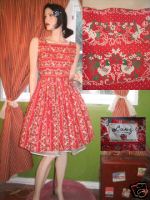

Another Lanz Original. Sweet mid-50’s dress with Tyrolean designs, made by the same label that produced the Magic Forest Dress I posted on Monday. And this one is a steal, current bid is about 12 bucks, so if you are super small (B 34”, W 26”) then hop to it. The square neckline is particularly fetching.
As I suspected, the Lanz clothing line, also known as Lanz of Salzburg, is straight outta Austria and began in 1922 producing traditional tracht (that’s the collective German name for all folkloric gear including dirndls [a dress with a close-fitted bodice and apron], lederhosen [literally: leather pants], and the knee socks that go with them). According to this excellent resource, Lanz came to New York in the Thirties and founded a sister company. After the war, they began producing more modern designs based on traditional patterns. Hence the cutesy prints and highly structured bodices.
There is also a Lanz of California which, by the early 50’s, was independent of the parent company but retained the Austrian influence in both fabric and design. Both Lanz Originals and Lanz of California are currently kaput. Lanz of Salzburg, continues as a designer of women’s sleepwear, and the Austrian company is still owned by the Lanz family and turning out tracht.
A note on tracht:
Okay, I was trying to avoid writing about it, but tracht ain’t all raindrops on roses. Having spent a few summers in southern Germany, and being a nice half-Jewish girl, I found that a lot of folks who wore traditional clothing had some downright traditional attitudes. You know, sexism, racism, anti-Semitism, that type of thing. In fact, the wearing of tracht was often something of a profession of conservative politics, and something that the local government subsidized.
That’s right, until 2004, the Bavarian state would reimburse you about 13% for your back-to-school lederhosen. And a nice pair of leather shorts are in the $200 range, as are well-made dirndls. The subsidy has since been nixed. It would be interesting to see how that has impacted who wears traditional clothing and why.
There is Germany, but then there’s Berlin, its antidote. This almost evens it all out. Beginning in Berlin, tracht has been rehabilitated in the past 10 years or so as cheeky club wear. One can now wear a dirndl totally tongue-in-cheek and everyone is in on the joke, so I’ve been told. When I dirndl around, I tend to add a wink and a nudge by accessorizing with a Khamza and a chai, though my fabulous Jewish nose is probably all I need.
I went to Vienna and it was closed. That’s a German joke. I went to Vienna only twice on weekends, so I don’t know much about tracht wearing there, but they do take a long siesta mid-day which definitely cut into my shopping time. As I understand it, Vienna has always done a brisk trade in tracht for tourists.
I was surprised to find that the dirndl has been fetishized as racy attire. I saw many a schlumpy dirndl with a long gray skirt and apron. A dirndl with a long skirt and high neck can look like a tired version of a Gunne Sax granny dress, indeed.
Southern Germany is unusual in that I saw just as many men in lederhosen as women in dirndls. Traditional clothing is generally still worn by women, even long after men have gone the way of t-shirts and jeans. The sari is a good example of this. In addition, the sari, like the dirndl, is subject to the whims of fashion. For my first sari, bought circa 1998, shop girls told me the choli blouse must be a lighter color than the sari. Now I hear that’s, like, so 90’s.


0 Comments:
Post a Comment
<< Home